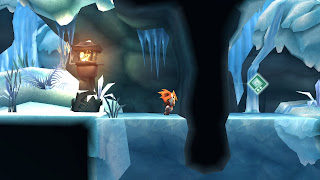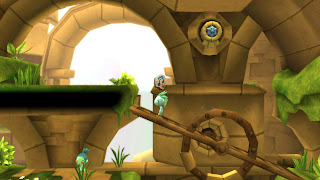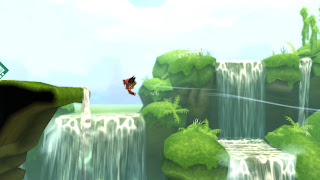After replaying LostWinds the other day, I was frankly disillusioned about the game, because I remembered it to be a lot better than it was. However, this may have something to do with its sequel, which is a pretty much everything a sequel should be...
It takes off right where the first game ended and sends you into the curiously named "Summerfalls", where everything is frozen. First thing you notice is that you get to keep all your wind abilities from the first game, imagine that. It's actually rare for this type of Action Adventure to do this, where they usually has to be an excuse why Link, Samus, and co. lose all their stuff and skills at the beginning of the next game. Not so with LostWinds 2. Only the "Jumberella Cape" is gone, which was quite overpowered, because you could just easily fly everywhere, so that's understandable. And of course there weren't that many upgrades in the first game to begin with, but it's still refreshing.
Instead it expands upon what was done in the first game by introducing a variety of new mechanics... The most important one is without a doubt the winter, where at first you need to stay close to lit torches or the cold will hurt you. Here the ability to carry fire with the wind, which was already possible in the first game, finds a new importance. The vortex can also be used to create giant snowballs, which is pretty clever.
And generally, freezing areas are a good idea for a restriction within an Action Adventure title, where for example Breath of the Wild had some potential here, but didn't make much use of it, because you can just simple get the Warm Doublet. Here you will also get the "Oloua Suit" to keep you warm, but you have to earn it by traveling through some cold areas first. I guess, you could even compare it to Metroid Prime 2, where you can't fully explore Dark Aether until you've found the Light Suit and until then you need to stay close to bubbles of light. Except that it doesn't take that long and this game world is a whole lot more pleasant, despite the cold.
This comparison isn't even too crazy, because with the winter in Winter of Melodias also comes a "dual world mechanic", where you can change the seasons between summer and winter at certain statues. It's visually impressive – it makes the whole game world look completely different and the atmosphere fully changes with it, very similar to that one part in Metroid Dread. And story-wise this is achieved by Sonté, the Spirit of Seasons, where there are multiple other spirits next to Enril, the Spirit of Wind
When it comes to the gameplay, however, the changes revolve around water for the most part. Ponds, lakes, rivers, and falls are all solid frozen in winter, often blocking off your path. Sometimes it's the opposite, where a strong current won't let you get up a hill in summer, but usually you can explore more space during the warm season. Prepare for lots of Melodia Idols found at the bottom of a lake...
So, there is some wasted potential, but overall the game was a great reminder how fantastic changing the seasons in a video game can be. The Zelda series has only done this twice, primarily with Oracle of Seasons, but also with the Mountain Village in Majora's Mask. And there is just a certain sense of wonder about this, where I heavily enjoy the progressing seasons in Animal Crossing: New Horizons as well. I'd love to see another Zelda game, preferably a top-down title, to make use of this idea again. Though, I would also settle for a remake of the Oracle games right now...
Changing between summer and winter is not the sole focus of Winter of the Melodias, however, where the last third of the game introduces a companion, very similar to Medli and Makar from The Wind Waker. Here most of the gameplay takes place in some ruins, which can only be visited during summer, so the game heavily shifts its theme and ideas here.
And this is quite interesting, because it's not a long game. It's less than an hour longer than LostWinds, which took me about two and a half hours to beat, where I had to backtrack quite a bit in both games to collect all Melodia Idols. There are twice as many in the second game to find, but they are as pointless and often hidden very predictably, so there is not much of an improvement here.
You can also now collect letters from your mother, who you are searching for in this game, which deliver some story and therefore are more interesting. But they are usually dropped along the way, so it's not really some secret collectible...
Like LostWinds, the game also ends after the first major boss battle, where the plot offers a much better resolve and everything feels more wholesome overall, despite the short length. The first game felt more like a demo in comparison.
But... both games talked about this ancient demon king, called "Balasar", who is the root of all the evil in the story. Its introduction may even feel very familiar to Zelda fans, because the depictions in LostWinds even use a similar art style to what Niko and Oshus have been showing you throughout their expositions in the Nintendo DS Zelda games. And Balasar is somewhat reminiscent of Bellum and Malladus, because it's this ancient mystery evil, while there are these different "spirits" of nature opposing him.
And with all that in mind, it seems like it was meant to be a trilogy, where a third game never came to see the light of day, sadly. The story wasn't interesting or exciting by any means, but I would have loved to see what gameplay ideas had come out of a third game, because Winter of the Melodias really stepped things up and brought the game to a whole new level, where for its short length it's packed with ideas.






